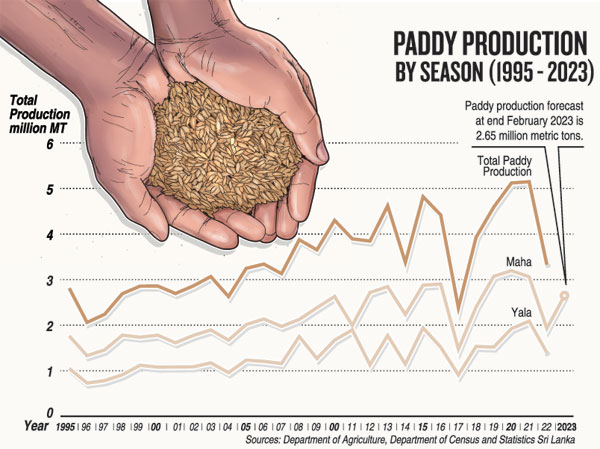News
Fertiliser glitches persist, while food security improves and production recovers
View(s):By Senuka Jayakody
A few more crop growing seasons will be needed for Sri Lanka to return to normalcy in food security, while a recovery is on the way.
In December last year, UNICEF had reported that the food insecurity caused by the economic crisis since early 2022 “is predicted to deteriorate between October 2022 and February 2023’’.
The report, ‘Humanitarian Action for Children report for 2023’ on December 6, 2022, said an estimated 6.2 million people (28%of the population) are moderately acute food insecure, while 66,000 people are severely acute food insecure.
Peradeniya University’s Crop Science Professor Buddhi Marambe said Sri Lanka would bounce back in the next three seasons, “unless the Government falls prey to various ideologies”.
He said food production is recovering.

He said he had advised the Government to import 200,000MT of rice for the last two-and-a-half months of 2022, but the Government went “overboard” and imported 783,000MT, spending US$ 260 million.
“Prices have stabilised, despite being relatively higher than expected. Rice is available. It is not a good thing and has to be monitored closely or the markets will crash.’’
Prof. Marambe said there was a lot of expectations of the Maha season, but the fertiliser situation had not been solved.
Muriate of potash shipments had landed on time, but there is a distribution issue.
For a third consecutive growing season, fields had been deprived of MOP or triple super phosphate.
However, Prof. Marambe expects the Maha season production to be lower by 20 percent but much better than the 2021/2022 Maha. He expects a good harvest in this year’s Yala season.
Global fertiliser prices have dropped “dramatically”. Last year, urea was bought at US$ 845 a ton, but the price has dropped to US$ 399 this year.
He said the next Maha season would be “crucial” since much of the foreign assistance Sri Lanka has received is “probably a one-time event”. Priority should be given to import these inputs for paddy, corn, and tea.
“The Government should consider the money spent on fertiliser and pesticide as an investment,’’ he said adding that the US$ 250 million spent to import rice would have been enough to import fertiliser for all crops for two seasons.
Paddy Marketing Board Deputy Coordination Officer Duminda Priyadarshana said he would predict a price hike again by yearend.
The reason is the Government’s decision to buy paddy through divisional secretariats. The PMB could not buy paddy to stock so that it could release when prices rise in October, November, and December.
“We know how to control the market, but when some traders buy paddy and there is no buffer stock for the Government, they can control the prices,’’ said Mr. Priyadarshana, who is also a researcher at the Hector Kobbekaduwa Agrarian Research Institute.
The ban on chemical fertiliser and agrochemicals caused the food crisis. The Maha production fell by 50 percent.
But, fertiliser has been distributed for the Maha season and the upcoming Yala. The Maha produce is estimated to be enough for seven to eight months.
As for vegetables, Mr. Priyadarshana expects an increase in prices next week because demand will rise and that distribution has stopped due to the National New Year.
Prices would stabilise after April 25. “This happens every year and there would be no abnormal situation.’’
While there is “no big food security issue,’’ the price of rice could rise, he said.
Dr. Suren Batagoda, the presidential advisor on national food security, said the food crisis was overcome through a collective effort.
He said field officers had been directed to find out families who may be starving, or suffering from malnutrition and to report. Hotlines had received more than 10,000 calls.
“Everybody did something and people reacted very well,’’ he said. Not only the Government but also companies, the UN’s World Food Programme, NGOs, the World Bank and many other institutions contributed through programmes such as providing pre-schools with morning meals.
“Except for the problem of egg production, the food situation has improved and is getting better,’’ Dr. Batagoda said. Although people have reduced food consumption, food is available.
His said seed and fertiliser should be freely available by the Yala season. “We are targeting exports as well.’’
Vimlendra Sharan, FAO representative for Sri Lanka and the Maldives, said the recently-concluded ‘Crop and Food Security Assessment Mission II’, shows that from 66,000 severely hungry people in March 2022 the figure has dropped to about 10,000.
Agricultural production, too, has picked up. Compared with the paddy production drop of 40%-50% last year, the just-concluded Maha output is likely to be lower by about 25%.
“We are hopeful that in the coming Yala, the country will see a normal production,’’ Mr Sharan said.
The best way to say that you found the home of your dreams is by finding it on Hitad.lk. We have listings for apartments for sale or rent in Sri Lanka, no matter what locale you're looking for! Whether you live in Colombo, Galle, Kandy, Matara, Jaffna and more - we've got them all!

